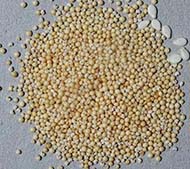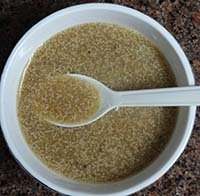Amaranth grain Nutrition facts
Amaranth grains are the tiny seeds in the Amaranthus family of plants. The grains are indeed treated as "millet" or "cereal" and consumed as an alternative option to regular staple foods such as rice and wheat. Ancient Mayans and Incas employed the seeds as a cereal in a similar way like quinoa and chia seeds.
Botanically, amaranth is a dicotyledonous plant wherein its leaves (amaranth-greens), as well as grains, are used as a staple food source even today. In fact, grain amaranth is the biggest non-grass "cereal-like" (pseudocereal) crop, followed by quinoa grown in the world.
 |
 |
| Amaranth plant with seedheads. Courtesy:Eileen Kane | Amaranth grains. Note for sesame seeds for comapison of size. |
Amaranth is not a member of the grass family (cereals) of staple grains. Instead, it is a seed much similar to other dicotyledons such as quinoa and legume family plants. Nonetheless, its seeds hold proportionately less fat than oilseeds and hence, are treated much like any other staple grains.
The main grain amaranth species are Amaranthus caudatus, A. cruentus, and A. hypochondriacus. The plant is drought-tolerant and adaptable to varying soil conditions. It normally grows to about 4 or 6 feet with maroon or crimson color seed heads.
The amaranth grains are tiny, only a millimeter in diameter, round to oval, usually off-white to brown in color, and one gram of seeds hold about 1,000-3,000 seeds.
Processing
Amaranth seed heads are rather loose and open like foxtail millet or finger millet (Ragi-Eleusine coracana). Farmers allow flowerheads to dry out on the plant before harvesting.
Amaranth grains are separated manually by threshing or using some mechanical process. Post-harvest practices are very important for maintaining high-quality grain.
Dried, cleaned grain should be placed in moisture-free storage with adequate ventilation to prevent mold damage.
10 amazing Health benefits of Amaranth grain
Grain amaranth, like quinoa, is not a cereal grain, but a dicotyledonous seed. Nonetheless, it is respected and employed like a cereal grain in line with other staples like wheat and millet.
It composes many nutrients in the right proportions including essential amino acids, essential fatty acids, starch, fiber, minerals, and vitamins.
Amaranth grains carry the same levels of calories as any other legumes and pseudocereals like quinoa. 100 g of seeds hold 371 calories.
Amaranth grains carry 13-15 g of protein per 100 g. It composes almost all of the essential amino acids required for the human body at great proportions, especially in lysine which is otherwise a limiting amino acid in grains like wheat, maize, rice, etc.
Amaranth is one of the gluten-free staple foods. Gluten is a protein present in certain grass family grains like wheat, which may induce stomach upset and diarrhea in individuals with gluten sensitivity or celiac disease.
The grains are a rich source of soluble and insoluble dietary fiber. 100 g provides 6.7 g or 17% of the daily requirement of fiber. Fibers in the food help prevent constipation by speeding up its movement through the gut. It also binds to toxins and removes them from the gut, and thereby, helps protect the colon mucosa from cancers.
Also, dietary fibers bind to bile salts (produced from cholesterol) and decrease their reabsorption in the colon, thus helping lower serum LDL-cholesterol levels.
The quality of B-complex vitamins in amaranth grains is superior to any cereals. Amaranth is indeed an excellent composition of folates, niacin, thiamin, and pantothenic acid.
Being seeds instead of cereal grains, amaranth indeed is an excellent source of vitamin E (α-tocopherol). 100 g of seeds carry 1.8 mg or 8% of the daily recommended levels of this vitamin.
The seeds are also a prominent source of essential fatty acids.
| Principle | Nutrient Value | Percent of RDA |
|---|---|---|
| Energy | 371 Kcal | 18.5% |
| Carbohydrates | 65.25 g | 50% |
| Protein | 13.56 g | 24% |
| Total Fat | 7.02 g | 35% |
| Cholesterol | 0 mg | 0% |
| Dietary Fiber | 6.7 g | 17.5% |
| Vitamins | ||
| Folates (B9) | 82 μg | 20.5% |
| Niacin (B3) | 0.923 mg | 5.5% |
| Riboflavin (B2) | 0.200 mg | 15% |
| Thiamin (B1) | 0.116 mg | 30% |
| Vitamin-A | 2 IU | <1% |
| Vitamin-E | 1.19 mg | 8% |
| Vitamin-K | 0 | 0% |
| Electrolytes | ||
| Sodium | 5 mg | <1% |
| Potassium | 563 mg | 12% |
| Minerals | ||
| Calcium | 159 mg | 16% |
| Iron | 7.61 mg | 95% |
| Magnesium | 248 mg | 62% |
| Phosphorus | 557 mg | 79% |
| Selenium | 8.5 μg | 15% |
| Zinc | 2.87 mg | 26% |
Selection and storage
Dry, whole grain, roasted as well as processed flour can be readily available in many specialty health food stores selling all around the season in the US.
Processed grain amaranth is generally sold in airtight packets and bulk bins. While buying from a local farmers' market, choose fine, dry grains in an air-tight package. Although amaranth flowerheads come in different colors, their grains, however, their grains can be dissimilar in color.
At home, store the grains in an airtight container in a cool, dry place where they stay fresh for several months. Milled amaranth flour, however, should be stored in metal containers, placed away from moisture and humidity.
Preparation and serving methods
 |
| Amaranth grain porridge. |
Ready-to-use amaranth seeds require little washing and soaking. They can be employed much like any other pseudo-cereals or millets.
The grains are cooked as is, in 2-3 parts water for 1 part amaranth for about 30 minutes, and are eaten like any other cereal. Cooked grains still have a slightly crunchy, nutty, and grainy texture.
Here are some serving tips:
-
Traditionally, native Mayans mix popped amaranth with honey (amaranth alegrias) as a breakfast food.
Alegría is a Mexican candy prepared from amaranth seeds and honey or brown sugar.
Amaranth seeds milled into flour and added in polenta, pancakes, and to prepare unleavened bread (Chapati).
In India and Nepal, puffed seeds are mixed with sugar syrup to prepare sweet snacks (Rajgira Laddu).
Whole seeds make a healthy and delicious porridge.
Cook whole seeds and drain any excess water, add cooked grains to make pilaf in a way similar to other millets and quinoa.
Amaranth flour is also used in the confectionary to make muffins, cakes, and energy bars.
Safety profile
Being dicotyledonous plant produce, amaranth grain contains some anti-nutritive compounds such as saponins and trypsin inhibitors in small quantities. These compounds impair protein digestion and absorption in the intestines. Steam cooking destroys many of these factors.
≻≻- You may also like to read
≺≺- Amaranth greens Nutrition facts and Health benefits.
≺≺- Pseudocereals for complete illustrations of their nutrition facts and health benefits.
≺≺- Back to Nuts and seeds from Amaranth grain. Visit here for an impressive list of nuts and seeds with complete illustrations of their nutrition facts and health benefits.
≺≺- Back to Home page.
Further Resources: